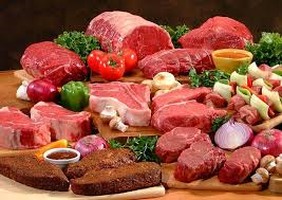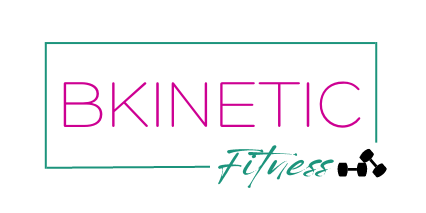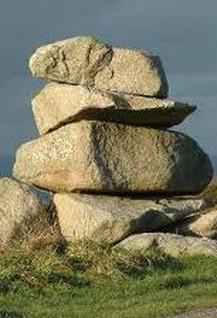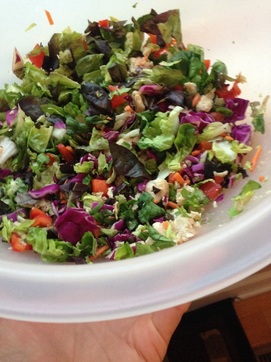Today is Day 7 of 31 Days of Fat Loss. Tuesdays are set aside for nutrition, which we can all agree is super important for fat loss, muscle gain, and overall health.
Let me ask you a question. If you were trying to build a stone wall, would you use large stones or would you painstakingly place pebbles and little rocks on top of each other? Which would give you the biggest bang for your buck? Which would help you build your wall faster and easier?
Well duh, Becky, you’d probably say. Of course the bigger stones would get us to our goal faster. And we know this.
But it’s not what we actually end up doing when it comes to fat loss or any other fitness goal that we might have. We tend to focus too much on the minutiae instead of getting the basics down pat. Why is this?
We all seem to have this idea that fat loss has to be complex, no doubt fueled by the thousands of diet books and blog posts available. We think that there must be some kind of secret. And that once we find it, it’ll be smooth sailing. So we hop from diet to diet, blog to blog, magazine article to article looking for that magic bullet.
It doesn’t exist.
What does work are the basics, the fundamental building blocks of fat loss and physique transformation. Those are the same for everyone. There are small tweaks here and there based on height, weight, hormones, training schedule, lifestyle, preferences, and goals.
But the basics are the foundation that must be mastered first. Only then, if necessary to continue seeing progress, would you even think about getting into all the other stuff.
Why do more than you have to? Why suffer if you don’t have to?

Focus on the “big rocks” of your nutrition:
Hydration
Aim for ½ of your bodyweight in ounces of water per day. For example, someone who weighs 175 lbs. will shoot for 87.5 ounces per day. Add more for exercise, hot outdoor weather, or dry indoor air. You can include green tea in this tally. Coffee, diet soda (the horror!), and other fluids are considered extra. Women who are perimenopausal or menopausal should consider drinking more, as our sense of thirst and sweat rate are affected by these hormonal changes.
Protein
Protein is very satiating (makes you feel fuller for longer) and provides the building blocks of muscle.A good rule of thumb is 0.8-1 gram of protein per pound of bodyweight.If you are significantly overweight, you can use lean mass instead.
Say you weigh 185 lbs. and your body fat percentage is 34%. Your lean mass would be 66% of your bodyweight, which would come out to around 122 lbs. of lean mass.
So you would want to consume around 122 grams of protein per day, which is a much more doable and reasonable amount compared to 185 grams. You can shoot for anywhere in that range, though.
Contrary to popular opinion, a high protein intake does not harm your kidneys (if you have kidney disease, consult your doctor of course), and “excess” protein does not turn into fat. An excess of any macronutrient will be stored as fat if your total caloric intake is above what your body needs. There’s nothing special about protein.
For more info on the safety of high protein diets, check out Layne Norton’s article here. He has a PhD in Nutritional Sciences and is an expert when it comes to protein.
If this is way higher than what you normally eat in a day, work up to it. Add 10-20 grams to your daily total each week until you hit your optimal number.
Produce
Fill up on vegetables — leafy greens, peppers, carrots, celery, cucumbers, squash, broccoli, cauliflower, and more. Add a small piece of fruit or a cup of berries to your day.
Fruit and veggies fill you up for fewer calories, are nutrient-dense, and provide tons of fiber (critical for good digestive health). They also aid in hydration.
A good goal to start with here would be 1-2 more servings per day than you are getting currently. Once this is easy to accomplish, add a few more. I’m partial to #BAS’s, or Big Ass Salads. I can get several servings of veggies in one meal.
Caloric Deficit
It’s the Law of Thermodynamics. While there are other factors that go into whether the body will burn fat or store it, there simply must be a caloric deficit to get the needle moving in our desired direction. The amount will be different for everyone, based on a variety of factors:
- metabolism
- height
- weight
- body type
- activity level
- amount of body fat and lean mass
- hormones
- stress
Some people want to be more aggressive in their approach, and may choose a larger deficit, such as 20%, while others will be better off with a more conservative approach of 10-15%. Someone who has more fat to lose can get away with a bigger deficit, while someone who is leaner and smaller in general should stick with the lower range to help prevent any ill effects (excessive fatigue, diminished recovery, hormonal imbalance, loss of muscle).
To give you some perspective, I am only 5 foot tall, and normally weigh around 110-112 lbs. Pretty small by anyone’s measure. This makes my BMR (basal metabolic rate) only 1,125 calories. This is the approximate amount of calories that my body burns at complete rest. Even with a fairly active lifestyle and almost daily workouts, I still only need about 1,646 calories per day, give or take. If I chose to cut 20% of those calories to aggressively lose body fat, it would drop it down to a paltry 1,317 calories per day.
Believe me, eating those few calories (or even less) day after day…you most definitely feel it. It impacts performance in the gym, recovery, energy levels during the day, quality of sleep, and mood. Not to mention, it’s just not a lot of food, no matter how healthy and calorically sparse. It’s hard to feel full and satisfied on that volume of food.
Even when I dieted down for my bikini competition last year, I was pretty conservative with my deficit. I ate as many calories and carbs that still allowed me to see results. I took my time and didn’t push myself to get it all done in 8-10 weeks. I was rewarded by a sane and at times enjoyable competition prep experience and no unwanted rebound weight gain in the weeks following the show. I had a good amount of energy throughout and very few mood swings (ß I’m sure my husband really appreciated that!).
You don’t necessarily need to count calories to do this, at least in the beginning. Just by substituting healthier options for your usual foods, cutting out a few sodas and juices, or cutting down portion sizes, you can create a deficit.
As you get leaner and your metabolism adapts to fewer calories and a lower bodyweight, you most likely will need to formally track your food and hit macronutrient targets to continue to see results (but only if this will not trigger any dysfunctional habits around food intake. Use your best judgment here).
If you can get a handle on these four big things, you’re more than halfway there!Get consistent with the big rocks before even thinking about the other stuff.
And consistency doesn’t mean being perfect; it means sticking with 80-90% of your plan 100% of the time (as my coach Jill Coleman of JillFit says).
What are some examples of “little rocks”?
- Carb-cycling
- Fasting
- Nutrient timing
- Supplements
- Meal frequency
- So-called “fat-burning foods” or “super foods”
These are more advanced methods that should only be incorporated when you’ve got the basics down and have hit a plateau.Sure, they can make a difference, but this is really only for people who are already pretty lean and want to get to the next level.These are mere pebbles compared to the boulders mentioned above.
There’s no need to make the fat loss process harder than it has to be. Being hardcore doesn’t always give you better results, especially long term. By following guidelines that work for you and your lifestyle and preferences, you ensure that you have a plan that you can use for life.
A diet doesn’t have to be complete and utter misery to be effective. Restriction and deprivation leads to binging and guilt, and ain’t nobody got time for that!
Let me know what you think over on the Facebook page! Which of the big rocks are you struggling with right now?




